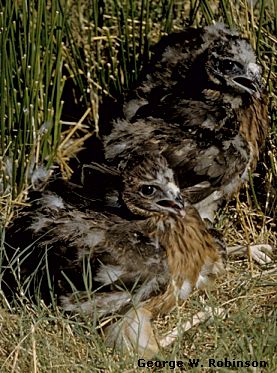Landscape, Animals, and Plants Home

Swainson's Hawk (Buteo swainsoni)
 Name
Derivation:
Name
Derivation:
Swainson's: for William Swainson (1789 - 1855). Born
in Great Britain, he developed an interest in natural history at an early
age, in part from his father who collected insects and shells. He worked
for the British Government in Malta and Sicily and spent a good deal of
time collecting in Italy and Greece. In 1816 he embarked on a 2-year trip
in Brazil to collect specimens. A revolt prevented him from collecting
much, so he taught himself lithography so that he could illustrate books.
He had trouble supporting his family on the earnings from his writing and
lithography, so in 1837 he emigrated to New Zealand to teach, farm, and
write. He died there in 1855.
Hawk: from the Teutonic
base word hab, meaning "to seize or take hold"; the word evolved
into Middle English hauk from which comes
"hawk".
Buteo: Latin term for
buzzard-hawk.
swainsoni: Latinized form of
"Swainson".
Other names:
Common American Buzzard, Swainson’s Buzzard; Spanish – aguililla de Swainson, gavilán chapulinero.
Systematics:
Class: Aves; Order: Falconiformes; Family: Accipitridae.
Key Identification Characters:
Adult: dark brown above, brown breast ("bib"), pale belly, at rest the wing tips extend beyond end of tail, head appears somewhat small; immature: dark brown upperparts edged with white, variable mottling of breast may form bib-like marking, wing tips extend beyond end of tail, head appears somewhat small; NOTE: some individuals "melanistic" and appear dark all over. Length, 19"; wingspan, 51".
Distribution:
Breeds in western North America, winters in Argentina, South
America.
El Paso Region: common migrant and nesting summer
resident.
Food:
Small mammals, birds, large insects, reptiles, and amphibians.
Breeding:
Number of eggs/clutch: range of 1 to 4, generally 2 to 3; egg: white, splashed and spotted with reddish brown and umber; 2.20" x 1.70"; nesting: generally in solitary tree or shrub, about 10' – 15' off ground; made of twigs, branches, debris; finer material used as a lining
Photo Credit: Young Swainson's Hawks. George W. Robinson © California Academy of Sciences.
Contributor: Scott M. Cutler, Curator of Collections and Exhibits; Curator of Ornithology.